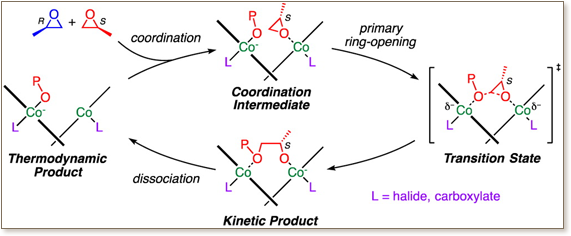
The enantioselective polymerization of propylene oxide (PO) using biaryl-linked bimetallic salen Co catalysts was investigated experimentally and theoretically. Five key aspects of this catalytic system were examined: (1) the structural features of the catalyst, (2) the regio- and stereoselectivity of the chain-growth step, (3) the probable oxidation and electronic state of Co during the polymerization, (4) the role of the cocatalyst, and (5) the mechanism of monomer enchainment. Several important insights were revealed. First, density functional theory (DFT) calculations provided detailed structural information regarding the regio- and stereoselective chain-growth step. Specifically, the absolute stereochemistry of the binaphthol linker determines the enantiomer preference in the polymerization, and the interaction between the salen ligand and the growing polymer chain is a fundamental aspect of enantioselectivity. Second, a new bimetallic catalyst with a conformationally flexible biphenol linker was synthesized and found to enantioselectively polymerize PO, though with lower enantioselectivity than the binaphthol linked catalysts. Third, DFT calculations revealed that the active form of the catalyst has two active exo anionic ligands (chloride or carboxylate) and an endo polymer alkoxide which can ring-open an adjacent cobalt-coordinated epoxide. Fourth, calculations showed that initiation is favored by an endo chloride ligand, while propagation is favored by the presence of two exo carboxylate ligands.
10.1021/ja409521z